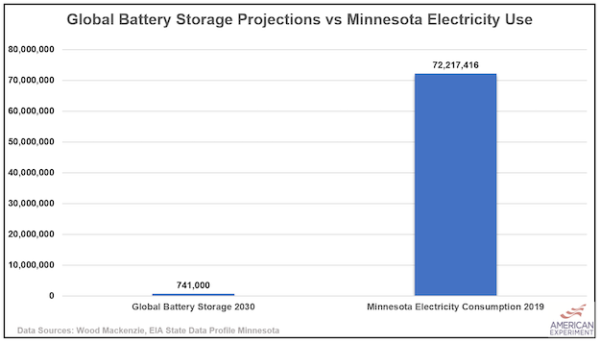Leftists fantasize that before long, we can dispense with all reliable energy sources–coal, natural gas, nuclear, even hydro–and run our society entirely on wind and solar, two forms of energy that have been obsolete for 150 years.
How can this be, since wind turbines only produce electricity when the wind is blowing sufficiently, which is around 40% of the time, and solar only works when the sun is shining and the panels are not covered in ice and snow–in a northern climate, something like 18% of the time? Obviously the Greenies have a problem. Today, their problem is solved by building natural gas plants that carry the load when wind and solar are AWOL–which is to say, a large majority of the time. Of course, the natural gas plants are dispatchable, which means they can produce energy reliably, at will, 24/7. Which raises the obvious question: if we have to build fully-capable natural gas plants to make wind and solar sort-of work, some of the time, what the heck to we need the wind and solar for?
The truthful answer to that question has nothing to do with the laws of physics, and everything to do with the laws of money. But the Left has another answer: batteries! It looks forward to the day when batteries will store the output of wind turbines and solar panels and thereby turn unreliable, intermittent energy into electricity that you can count on to turn on your lights when you flip the switch.
At American Experiment.org, my colleague Isaac Orr demolishes the Green New Deal fantasy. One basic problem is that wind turbines don’t work when the weather gets cold, which can be fatal in the North, especially when we are experiencing a brutal cold snap:
Temperatures are below zero in many parts of the state, but wind energy is missing in action.
According to data from the regional grid operator, the wind is providing just 1 percent of the current electricity on the grid, and solar is providing just 0.31 percent. Coal currently accounts for 55 percent of generation, natural gas accounts for 28 percent, and nuclear accounts for 14 percent.
Not only is wind not producing much electricity, but it is also producing only a small fraction of its potential output. There are 22,000 megawatts (MW) of wind capacity installed on the regional grid, but these wind turbines are only producing 1,055 MW of electricity. In other words, wind turbines are only producing 4.8 percent of their potential output. Temperatures are below zero in many parts of the state, but wind energy is missing in action.
As Isaac has explained elsewhere, the truth is even worse than that. When it gets cold, not only are wind turbines shut down so they produce no electricity, they also need to be kept warm. So in cold weather, wind turbines are consumers of electricity, not producers of electricity.
This looks bleak for the Greenies. But their deus ex machina is batteries. The battle may appear lost, but vast (infinite) supplies of lithium batteries will somehow appear to save the day. Where to we go to buy those batteries? Well, they don’t actually exist. But someday they will! Isaac writes:
A recent analysis by the consulting firm Wood Mackenzie estimates there will be about 741 gigawatt-hours of battery storage in 2030. This amount equates to 741,000 megawatt-hours (MWh). These may sound like big numbers, but the figures are actually damning evidence that battery storage is an entirely unserious energy proposal.
In 2019, the state of Minnesota consumed 72 million megawatt-hours of electricity. This means the amount of battery storage expected to be in existence for the entire world would be the equivalent of just one percent of Minnesota’s annual energy consumption.

But that’s not all!
Not only will the needed battery storage not exist, but it’s also incredibly expensive.
Current cost estimates for battery storage are about $250 per kilowatt-hour, which equates to a cost of $250,000 per megawatt-hour. This means the cost of all the expected battery storage in the world (741,000 MWh by 2030) would cost $185 billion to build, and this doesn’t even begin to include the cost of building the wind turbines and solar panels needed to charge the batteries!
More fundamentally, that $185 billion is just to build batteries that can store one percent of Minnesota’s electricity needs. (For comparison, Minnesota’s GDP is $339 billion.) Where the remaining 99% of Minnesota’s needs, and the needs of the rest of the planet, will come from, is anyone’s guess. And you can easily do the math and see that no such scheme is even remotely possible, let alone affordable.
Add in the fact that battery storage only lasts for 10 years, according to the National Renewable Energy Laboratory, and it becomes blindingly obvious that we should instead be focusing on building new nuclear power plants that will come online faster and produce much more electricity for a much lower cost.
That recommendation is beyond question if the goal is to provide ordinary Americans with cheap and reliable energy without emitting carbon dioxide. But that is not the goal of environmentalists or of the Green New Deal. To be blunt, they couldn’t care less whether peons have reliable access to energy, or how much they have to pay for it. A great deal of money stands to be made by green-allied companies and utilities. Why? Because the peons will be paying so much. When this sort of payoff is in the offing, science will not be allowed to get in the way.
Notice: All comments are subject to moderation. Our comments are intended to be a forum for civil discourse bearing on the subject under discussion. Commenters who stray beyond the bounds of civility or employ what we deem gratuitous vulgarity in a comment — including, but not limited to, “s***,” “f***,” “a*******,” or one of their many variants — will be banned without further notice in the sole discretion of the site moderator.